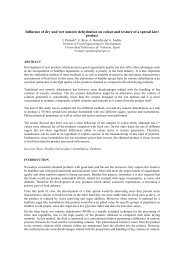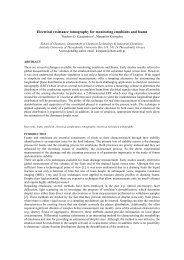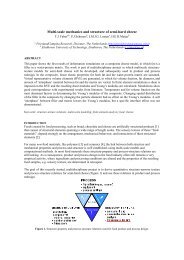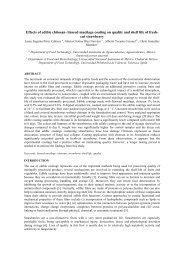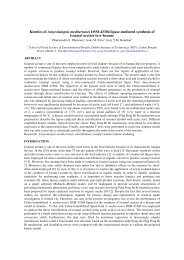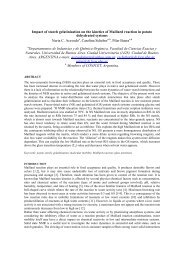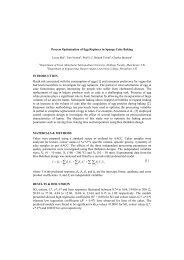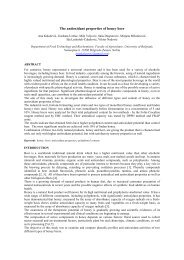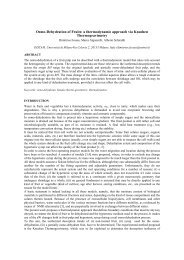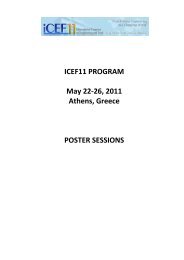Icef full paper - 11th International Congress on Engineering and Food
Icef full paper - 11th International Congress on Engineering and Food
Icef full paper - 11th International Congress on Engineering and Food
You also want an ePaper? Increase the reach of your titles
YUMPU automatically turns print PDFs into web optimized ePapers that Google loves.
Release of natamycin from alginate <strong>and</strong> pectin films intended for food packaging<br />
Andréa Cristiane Krause Bierhalz a , Mariana Altenhofen da Silva a , Theo Guenter Kieckbusch a<br />
a School of Chemical <strong>Engineering</strong>, University of Campinas, Campinas, Brazil (theo@feq.unicamp.br)<br />
ABSTRACT<br />
Packages with antimicrobial activity provide a promising form of active packaging systems applicable in<br />
food processing. Polysaccharides, especially alginate <strong>and</strong> pectin, are good c<strong>and</strong>idates to be used in active<br />
films since they show excellent functi<strong>on</strong>al properties <strong>and</strong> are biodegradable. In this study, single <strong>and</strong><br />
composite films based <strong>on</strong> alginate <strong>and</strong> pectin c<strong>on</strong>taining natamycin as active agent were prepared <strong>and</strong> the<br />
release behavior in water <strong>and</strong> the diffusi<strong>on</strong> coefficients were evaluated. The influence of natamycin <strong>on</strong><br />
opacity, soluble matter in water <strong>and</strong> mechanical properties of the films were also investigated. Diffusi<strong>on</strong><br />
coefficients were determined using a soluti<strong>on</strong> to Fick’s Law for a plane sheet <strong>and</strong> the mechanism<br />
involved in the diffusi<strong>on</strong>al process was investigated using the Power Law Model. Additi<strong>on</strong> of natamycin<br />
promoted an increase in soluble matter in water <strong>and</strong> opacity <strong>and</strong> decreased the tensile strength when<br />
compared to films without the added anti-microbial agent. The natamycin mass released by immersi<strong>on</strong> of<br />
the film in water fitted well to Fick’s sec<strong>on</strong>d law diffusi<strong>on</strong>al model, with effective diffusivity values<br />
ranging from 9.53.10 -9 (single pectin films) to 9.22.10 -12 cm 2 /s (single alginate films). The values of the<br />
diffusi<strong>on</strong>al exp<strong>on</strong>ents ranged between 0.5 <strong>and</strong> 1.0, suggesting that the transport process had n<strong>on</strong>-Fickian<br />
(anomalous) characteristics <strong>and</strong> a solvent diffusi<strong>on</strong> rate of the same order of magnitude as the polymer<br />
relaxati<strong>on</strong>. The single alginate films exhibit more suitable attributes for use in packaging than the single<br />
pectin <strong>and</strong> composite films, indicating a greater potential for use as systems for release of active<br />
substances.<br />
Keywords: active film; alginate; pectin; natamycin; diffusi<strong>on</strong> coefficient<br />
INTRODUCTION<br />
The increasing dem<strong>and</strong> for safer <strong>and</strong> minimally processed food products has intensified the research <strong>on</strong><br />
antimicrobial packaging. This innovative c<strong>on</strong>cept of packaging can prevent the product’s deteriorati<strong>on</strong>,<br />
extending the shelf life <strong>and</strong> maintaining the sensorial attributes <strong>and</strong> safety of several food products [1].<br />
Biodegradable films prepared from polysaccharide materials, such as algintate <strong>and</strong> pectin can be used to<br />
incorporate antimicrobials agents, delivering them to the food surfaces, where deteriorati<strong>on</strong> by microbial<br />
growth often begins.<br />
Alginates are hydrophilic polysaccharides derived from brown algae known as Phaeophyceae Alginates<br />
are composed of (1,4)-linked β-D-mannur<strong>on</strong>ate (M) <strong>and</strong> α-L-gulur<strong>on</strong>ate (G) units, which are present in<br />
the linear macromolecule as homopolymeric blocks (poly-M <strong>and</strong> poly-G), together with blocks in<br />
alternating sequence (MG) [2]. Pectin is the main comp<strong>on</strong>ent of the citrus processing by-products <strong>and</strong> <strong>on</strong>e<br />
of the most widely studied i<strong>on</strong>ic polysaccharides with useful <strong>and</strong> versatile properties in many<br />
applicati<strong>on</strong>s. The basic chemical structure of pectin is a linear polymer of D-galactur<strong>on</strong>ic acid units with<br />
their methyl esters c<strong>on</strong>nected through α-(1,4)-glycosidic b<strong>on</strong>ds [3]. According to their degree of<br />
methylati<strong>on</strong>, pectins are divided into two categories: low-methoxyl pectins (LMP) <strong>and</strong> high methoxyl<br />
pectins (HMP), with a degree of methylati<strong>on</strong> respectively lower <strong>and</strong> higher than 50%. The degree of<br />
methylati<strong>on</strong> has a decisive effect <strong>on</strong> the mechanisms of gelati<strong>on</strong> [4]. The extensive use of these two<br />
polymers arises from their ability to form gels in the presence of divalent cati<strong>on</strong>s such as calcium i<strong>on</strong>s [2].<br />
The more comm<strong>on</strong>ly antimicrobials used to preserve food are organic acids such as benzoic <strong>and</strong> sorbic<br />
acids, bacteriocins such as nisin <strong>and</strong> some plant extracts [5]. Natamycin is a natural antifungal agent<br />
produced during fermentati<strong>on</strong> by the bacterium Streptomyces natelensis <strong>and</strong> is widely used in the food<br />
industry for the preventi<strong>on</strong> of mold c<strong>on</strong>taminati<strong>on</strong> of meats, cheese <strong>and</strong> fruits [6].<br />
Several studies have been d<strong>on</strong>e <strong>on</strong> the release of antimicrobials incorporated into different packaging [7,<br />
8, 9, 10]. Since the efficiency of antimicrobial films is based <strong>on</strong> the diffusi<strong>on</strong> of active substances from<br />
the polymeric matrix to the food, the knowledge of the diffusivity of these compounds is a determinant<br />
factor in the development of an antimicrobial food packaging system [8]. A slower release <strong>and</strong>, therefore,<br />
a lower diffusi<strong>on</strong> coefficient is desirable in this applicati<strong>on</strong> to maintain a critical surface c<strong>on</strong>centrati<strong>on</strong> of<br />
preservative [10].
The physical <strong>and</strong> chemical properties of the film are also important for packaging system efficiency.<br />
Additi<strong>on</strong> of antimicrobial agents may cause changes in the polymeric structure of the film, affecting its<br />
mechanical properties <strong>and</strong> effectiveness as a barrier [11,12] Thus, possible interacti<strong>on</strong>s between<br />
antimicrobial agents <strong>and</strong> biopolymers should be c<strong>on</strong>sidered in the development of active packaging.<br />
In this work, single <strong>and</strong> composite films based <strong>on</strong> alginate <strong>and</strong> pectin c<strong>on</strong>taining natamycin as active<br />
agent were prepared <strong>and</strong> the release behavior in water <strong>and</strong> the diffusi<strong>on</strong> coefficients were evaluated. The<br />
influence of natamycin <strong>on</strong> thickness, opacity, soluble matter in water <strong>and</strong> mechanical properties of the<br />
films were also investigated.<br />
MATERIALS & METHODS<br />
Materials<br />
Medium viscosity sodium alginate, extracted from Macrocystis pyrifera seaweed, was purchased from<br />
Sigma–Aldrich (St. Louis, USA) <strong>and</strong> amidated low methoxy pectin (LM 101AS) d<strong>on</strong>ated by of CPKelco<br />
(Limeira, Brazil), were used as biopolymers matrices in the composite <strong>and</strong> single films. Calcium chloride<br />
dihydrate (Merck, Darmstadt, Germany) was used as crosslinking agent <strong>and</strong> glycerol (Synth, Diadema,<br />
Brazil) as plasticizer. Natamycin (Natamax ® ), kindly d<strong>on</strong>ated by Danisco (São Paulo, Brazil), was used as<br />
antimicrobial agent.<br />
Film preparati<strong>on</strong><br />
Alginate, pectin <strong>and</strong> alginate/pectin (1:1) films were made by casting in a two-stage crosslinking<br />
procedure. In the first stage, a film forming soluti<strong>on</strong> of biopolymer (1.5 g/100 mL) was prepared in 400<br />
mL distilled water already c<strong>on</strong>taining 0.6 g glycerol/g biopolymer at room temperature. The soluti<strong>on</strong> was<br />
mechanically stirred at 900 rpm (Tecnal, TE-139, Piracicaba, Brazil) for about 1 h to ensure homogeneity.<br />
Afterwards, the temperature of the system was raised to 70ºC <strong>and</strong> a dilute aqueous calcium chloride<br />
soluti<strong>on</strong> (30 mL) was slowly added to the biopolymer soluti<strong>on</strong> at a flow rate of 1 mL/min delivered by a<br />
peristaltic pump (Masterflex C/L, model 77120-70, Vern<strong>on</strong> Hills, USA) until a total amount of 0.05 g<br />
CaCl 2 .2H 2 O/g biopolymers was transferred. Aliquots of the soluti<strong>on</strong> (50 mL) were poured into square<br />
plaxiglass frames (225 cm 2 ) <strong>and</strong> dried in a c<strong>on</strong>vecti<strong>on</strong> oven (Fanem, model 099EV, Guarulhos, Brazil) at<br />
40ºC for about 20 h.<br />
After detaching the resulting film from the support, the crosslinking was complemented in a sec<strong>on</strong>d stage<br />
c<strong>on</strong>tact, by total immersi<strong>on</strong> of the films in 50 mL of an aqueous calcium chloride soluti<strong>on</strong> (5% w/v)<br />
c<strong>on</strong>taining glycerol (3% v/v) for 20 min. The excess surface liquid was removed <strong>and</strong> the films were dried<br />
in a ventilated ambient for about 5 h, at room temperature. All films were c<strong>on</strong>diti<strong>on</strong>ed at room<br />
temperature <strong>and</strong> 52% relative humidity inside desiccators for 3 days before submissi<strong>on</strong> to physical<br />
characterizati<strong>on</strong>.<br />
The active films were prepared as described previously using 4g natamycin/100g alginate added to the<br />
polymeric soluti<strong>on</strong> c<strong>on</strong>taining calcium chloride (first stage). The system was further stirred for another 10<br />
minutes before casting.<br />
Film thickness (δ)<br />
The film thickness was c<strong>on</strong>trolled by pouring a c<strong>on</strong>stant mass (50 g) of the film forming soluti<strong>on</strong> over the<br />
support. Digital micrometer (Mitutoyo, MDC-25S, Naulcapan de Juárez, Mexico) was used to measure<br />
the thickness of c<strong>on</strong>diti<strong>on</strong>ed films. Ten measurements were taken at r<strong>and</strong>om positi<strong>on</strong>s.<br />
Soluble matter in water (S w )<br />
The soluble matter in water of the films was measured as proposed by Irissin-Mangata et al. [13]. The<br />
moisture weight fracti<strong>on</strong>, ω, of the film was gravimetrically determined in a vacuum oven (Lab-Line,<br />
Squaroid, USA) at 105ºC for 24 h. Disks cut from the same film, were weighed <strong>and</strong> immersed in 50 mL<br />
of distilled water using a 250 mL beaker maintained under mild agitati<strong>on</strong> (150 rpm) at 25ºC for 24 h<br />
(Shaker Bath Orbit, Lab-Line, USA). The final dry matter of the sample was determined in the same<br />
vacuum oven (105ºC/24 h). The fracti<strong>on</strong>al solubilized matter (S w ) was calculated as a functi<strong>on</strong> of the<br />
initial dry matter.<br />
Mechanical properties<br />
Tensile strength (TS) <strong>and</strong> el<strong>on</strong>gati<strong>on</strong> at break (TE) of the prec<strong>on</strong>diti<strong>on</strong>ed films were determined at room<br />
temperature using a TA.XT2 (Stable Microsystems SMD, Surrey, UK) according to ASTM st<strong>and</strong>ard<br />
method D882 [14]. Films were cut into strips (10 x 2.54 cm) <strong>and</strong> mounted between the tensile grips of the<br />
instrument. The initial grip spacing <strong>and</strong> cross-head speed were set at 5 cm <strong>and</strong> 0.1 cm/s, respectively. A
microcomputer was used to record the stress–strain curves. The tensile strength was expressed as the<br />
maximum force at break per initial transversal area of the film <strong>and</strong> the el<strong>on</strong>gati<strong>on</strong> as a percentage of the<br />
original length.<br />
Opacity (O p )<br />
The opacity of the films was determined in triplicate using a Colorquest II colorimeter (Hunterlab,<br />
Virginia, USA) operating in the transmittance mode according to Hunterlab method [15]. Opacity was<br />
calculated by the equipment software, as the relati<strong>on</strong>ship am<strong>on</strong>g the opacity of each sample over the black<br />
st<strong>and</strong>ard <strong>and</strong> the opacity of each sample over the white st<strong>and</strong>ard.<br />
Natamycin migrati<strong>on</strong> test<br />
Square film samples (4 cm 2 ) were immersed in a beaker c<strong>on</strong>taining 25 mL of distilled water under gentle<br />
agitati<strong>on</strong> (150 rpm) in a shaker (Shaker Bath Orbit, Lab-Line, USA) at a temperature of 25°C. After a<br />
predetermined period of time, the film was quickly transferred to a sec<strong>on</strong>d water c<strong>on</strong>tainer. This<br />
procedure was repeated from <strong>on</strong>e beaker to another until no further release of natamycin could be<br />
detected. The natamicyn c<strong>on</strong>centrati<strong>on</strong> in the beakers was determined with UV/VIS spectrophotometer<br />
(HP, model 8453, USA) over a wave length range of 290 to 350 nm. The natamycin c<strong>on</strong>centrati<strong>on</strong> was<br />
obtained by measuring the amplitude of the peak at 317 nm. The accumulated mass of natamycin<br />
released, M t , was calculated <strong>and</strong> plotted as M t /M ∞ as a functi<strong>on</strong> of time, where M t /M ∞ is the fracti<strong>on</strong>al<br />
natamycin release. The mean film thickness was determined before <strong>and</strong> after each experiment.<br />
Diffusi<strong>on</strong> coefficient determinati<strong>on</strong><br />
Diffusi<strong>on</strong> coefficients were determined from the data obtained using a relati<strong>on</strong>ship derived from the<br />
soluti<strong>on</strong> to Fick’s Law for a flat plate [16]. Under the c<strong>on</strong>diti<strong>on</strong>s of the experiments, <strong>and</strong> assuming a<br />
c<strong>on</strong>stant total film thickness, δ, the following equati<strong>on</strong> (Eq. 1) can be adapted for the fracti<strong>on</strong>al natamycin<br />
release.<br />
⎛ π<br />
( )<br />
⎟ ⎞<br />
= − ∑ ∞ 2<br />
Mt 8 1<br />
2 D<br />
1<br />
exp<br />
⎜−<br />
2n + 1 t<br />
(1)<br />
2<br />
2<br />
2<br />
M∞<br />
π n=<br />
0 (2n + 1) ⎝ δ ⎠<br />
where D is the average effective diffusivity of natamycin, assumed c<strong>on</strong>stant.<br />
For short c<strong>on</strong>tact times, when less than 60% of the solute mass is liberated, a simplified soluti<strong>on</strong> of Fick’s<br />
Sec<strong>on</strong>d Law can be used (Eq. 2):<br />
M t Dt<br />
= 4<br />
(2)<br />
2<br />
M δ π<br />
∞<br />
Polymeric matrices are pr<strong>on</strong>e to undergo structure relaxati<strong>on</strong> under the influence of the penetrating<br />
solvent or solute molecules <strong>and</strong> anomalous transport mechanisms can prevail for some situati<strong>on</strong>s. A<br />
comm<strong>on</strong> way to investigate the mechanism involved in the diffusi<strong>on</strong> process for a planar system is by<br />
fitting the early porti<strong>on</strong> of the release curve (M t /M ∞
opacity, mechanical properties <strong>and</strong> soluble matter in water of single <strong>and</strong> composites alginate/pectin films<br />
are shown in Table 1.<br />
Table 1. Thickness (δ), soluble matter in water (S w ), tensile strength (TS), el<strong>on</strong>gati<strong>on</strong> at break (TE) <strong>and</strong> opacity (O p )<br />
of films without natamycin (c<strong>on</strong>trol films) <strong>and</strong> with natamycin (active films).<br />
Film δ (µm)** S w (%)* TS (MPa)** TE (%)** O p (%)*<br />
Pectin<br />
C<strong>on</strong>trol films 19 (0.9) c 24.53 (0.54) b 65.49 (5.52) d 4.66 (0.44) b 4.55 (0.06) f<br />
Active films 20 (1.1) c 45.52 (1.79) a 48.46 (5.93) e 4.75 (0.37) b 51.98 (0.89) b<br />
Pec/Alg<br />
C<strong>on</strong>trol films 25 (3.1) b 16.92 (1.97) d 94.53 (3.43) b 4.68 (0.53) b 7.85 (0.48) e<br />
Active films 25 (1.9) b 25.66 (4.76) b 80.87 (7.08) c 4.81 (0.45) b 57.20 (0.86) a<br />
Alginate<br />
C<strong>on</strong>trol films 30 (2.2) a 19.03 (1.22) c 122.51 (3.27) a 6.59 (0.72) a 13.12 (0.06) d<br />
Active films 30 (2.1) a 17.74 (1.98) cd 106.73 (4.99) b 6.84 (1.09) a 48.57 (0.39) c<br />
Average (st<strong>and</strong>ard deviati<strong>on</strong>) of three (*) <strong>and</strong> ten (**) experimental determinati<strong>on</strong>s.<br />
Average with the same letter, in the same column, indicate no significant difference (p
Diffusi<strong>on</strong> coefficients of natamycin from single <strong>and</strong> composite films were estimated by adjusting the<br />
experimental points to Equati<strong>on</strong> 1 using 15 terms in the summati<strong>on</strong>. Initial experimental data (M t /M ∞ <<br />
0.6) were also adjusted to the diffusi<strong>on</strong> model for short c<strong>on</strong>tact times (semi-infinite solid model) using<br />
Equati<strong>on</strong> 2. These values, the correlati<strong>on</strong> coefficient as well the time of equilibrium found for each<br />
situati<strong>on</strong> studied are shown in Table 2.<br />
Table 2. Time to equilibrati<strong>on</strong> (t), diffusi<strong>on</strong> coefficients (D), diffusi<strong>on</strong> exp<strong>on</strong>ent (n) <strong>and</strong> diffusi<strong>on</strong>al c<strong>on</strong>stant (k) of<br />
pectin, alginate <strong>and</strong> composite films c<strong>on</strong>taining natamycin<br />
Film t (h) D 1 (cm 2 /s) R 1 D 2 (cm 2 /s) R 2 n k (s -1 )<br />
Pectin 30 3.22.10 -9 0.9963 3.92.10 -9 0.9991 0.5744 4.54.10 -3<br />
Pec/Alg 70 2.80.10 -10 0.9834 3.92.10 -10 0.9989 0.7258 6.56.10 -4<br />
Alginate 800 9.18.10 -12 0.9986 1.11.10 -11 0.9988 0.6028 4.32.10 -4<br />
1 Diffusi<strong>on</strong> coefficient <strong>and</strong> correlati<strong>on</strong> coefficient found from Equati<strong>on</strong> 1.<br />
2 Diffusi<strong>on</strong> coefficient <strong>and</strong> correlati<strong>on</strong> coefficient found from Equati<strong>on</strong> 2.<br />
Comparing the times to equilibrati<strong>on</strong> results (t), it can be observed that natamycin release was slower in<br />
single alginate films. Pectin films reached equilibrium in approximately 30 hours, while this period<br />
increased to 70 hours for composite films <strong>and</strong> over 800 hours for alginate films. These results reinforce<br />
the hypothesis that natamycin presents higher compatibility with alginate than with pectin. The rapid<br />
release of natamycin from pectin films also explains the high soluble matter in water value observed in<br />
Table 1.<br />
As expected, the diffusivity coefficients decreased significantly when alginate was added to the<br />
formulati<strong>on</strong>. The largest difference in results between the two fitting approaches used (D 1 <strong>and</strong> D 2 ), was<br />
observed with the pectin film, which indicates that the diffusi<strong>on</strong> is more influenced by swelling. Bajpai et<br />
al. [21] produced alginate <strong>and</strong> pectin beads crosslinked with calcium <strong>and</strong> studied the release of potassium<br />
nitrate in water. The authors observed that the release rate increased with an increase in the pectin<br />
c<strong>on</strong>centrati<strong>on</strong>. This behavior was attributed to the higher hydrophilicity of pectin, which causes relaxati<strong>on</strong><br />
of the chains, resulting in faster release of the active agent. The films with higher proporti<strong>on</strong>s of alginate<br />
also had a higher degree of crosslinking <strong>and</strong> created difficulties for natamycin mobility. Zactiti &<br />
Kieckbusch [8] observed that the diffusivity of potassium sorbate in water decreased when the<br />
c<strong>on</strong>centrati<strong>on</strong> of calcium used in the crosslinking of alginate films was increased.<br />
Although the diffusivity was higher for pectin films, the observed values were low compared to other<br />
results <strong>on</strong> release of antimicrobial agents. For example, values found in the literature for potassium<br />
sorbate, lisosyme <strong>and</strong> sorbic acid diffusivities are in the order of 10 -8 cm 2 /s [9, 22, 23].<br />
Diffusi<strong>on</strong> exp<strong>on</strong>ents for the Power Law Model (Equati<strong>on</strong> 3) were obtained by plotting ln (M t /M ∞ ) versus<br />
ln (t). The diffusi<strong>on</strong>al exp<strong>on</strong>ent (n) was calculated from the angular coefficients <strong>and</strong> the diffusi<strong>on</strong>al<br />
c<strong>on</strong>stant (k) was obtained from the linear coefficients of the fitting line. As shown in Table 2, all<br />
formulati<strong>on</strong>s presented a diffusi<strong>on</strong>al exp<strong>on</strong>ent (n) between 0.5 <strong>and</strong> 1, which are characteristic of<br />
anomalous diffusi<strong>on</strong>, a mechanism in which the diffusi<strong>on</strong> rate of the solvent <strong>and</strong> the relaxati<strong>on</strong> of the<br />
polymeric chains are of the same order of magnitude. The deviati<strong>on</strong> from Fickian behavior indicates that<br />
the polymer relaxati<strong>on</strong> phenomen<strong>on</strong> is more prominent <strong>and</strong> may affect the release of natamycin during<br />
the first moments of the process [17]. An anomalous diffusi<strong>on</strong> mechanism was also observed by Zactiti &<br />
Kiecbusch [8] for alginate films with potassium sorbate. Flores et al. [24] <strong>and</strong> Ozdemir <strong>and</strong> Floros [22]<br />
also observed deviati<strong>on</strong>s from ideal Fickian behavior during release of potassium sorbate from starch <strong>and</strong><br />
protein films, respectively.<br />
CONCLUSION<br />
The incorporati<strong>on</strong> of natamycin as an antimicrobial agent affected tensile strength <strong>and</strong>, particularly, the<br />
opacity of active films. When pectin was used as a biopolymer, the results revealed that natamycin was<br />
not homogenously incorporated into the structure, which caused its rapid release as well as high water<br />
solubility values. Composite films tended to present intermediary properties when compared to both<br />
simple films. The diffusi<strong>on</strong> coefficient obtained by adjusting the experimental data to Fick’s sec<strong>on</strong>d law<br />
varied from 9.53.10 -9 to 9.22.10 -12 cm 2 /s. The good compatibility of natamycin with alginate, the low<br />
diffusi<strong>on</strong> coefficient <strong>and</strong> the excellent physical properties indicate that this film has great potential for use<br />
in antimicrobial packaging.
Acknowledgments<br />
The authors acknowledge The State of São Paulo Research Foundati<strong>on</strong> – FAPESP for financial support<br />
(Proc. 2008/52830-9).<br />
REFERENCES<br />
[1] Han J.H. 2000. Antimicrobial food packaging. <strong>Food</strong> Technology, 54(3), 56-65,<br />
[2] Fang Y., Al-Assaf S., Phillips G.O., Nishinari K., Funami T. & Williams P.A. 2008. Binding behavior of calcium<br />
to polyur<strong>on</strong>ates: Comparis<strong>on</strong> of pectin with alginate. Carbohydrate Polymers, 72(2), 334-341<br />
[3] Sriamornsak P. & Kennedy R.A. 2008. Swelling <strong>and</strong> diffusi<strong>on</strong> studies of calcium polysaccharide gels intended for<br />
film coating. <str<strong>on</strong>g>Internati<strong>on</strong>al</str<strong>on</strong>g> Journal of Pharmaceutics, 358(1-2), 205-213.<br />
[4] Gigli J., Garnier C. & Piazza L. 2009. Rheological behaviour of low-methoxyl pectin gels over an extended<br />
frequency window. <strong>Food</strong> Hydrocolloids, 23(5), 1406-1412.<br />
[5] Limjaroen P., Ryser E., Lockhart H. & Harte B. 2003. Development of a food packaging coating material with<br />
antimicrobial properties. Journal of plastic film <strong>and</strong> sheeting, 19(2), 95-109.<br />
[6] Chen G-Q., Lu F-P. & Du L-X. 2008. Natamycin producti<strong>on</strong> by Streptomyces gilvosporeus based <strong>on</strong> statistical<br />
optimizati<strong>on</strong>, Journal of Agricultural <strong>and</strong> <strong>Food</strong> Chemistry, 56(13), 5057-5061.<br />
[7] Ozdemir M. & Floros J.D. 2001. Analysis <strong>and</strong> modeling of potassium sorbate diffusi<strong>on</strong> through edible whey<br />
protein films, Journal of <strong>Food</strong> <strong>Engineering</strong>, 47(2), 149-155.<br />
[8] Zactiti E.M. & Kieckbusch T.G. 2009. Release of potassium sorbate from active films of sodium alginate<br />
crosslinked with calcium chloride, Packaging Technology <strong>and</strong> Science, 22(6), 349-358.<br />
[9] Bu<strong>on</strong>ocore G.G., Del Nobile M.A., Panizza A. & Corbo M.R. 2003. A general approach to describe the<br />
antimicrobial release from highly swellable films intended for food packaging applicati<strong>on</strong>s, Journal of C<strong>on</strong>trolled<br />
Release, 90(1), 97-107.<br />
[10] Franssen L.R., Rumsey T.R. & Krochta J.M. 2004. Whey protein film compositi<strong>on</strong> effects <strong>on</strong> potassium sorbate<br />
<strong>and</strong> natamycin diffusi<strong>on</strong>, Journal of <strong>Food</strong> Science, 69(5), 347-350.<br />
[11] Pranoto Y., Salokhe V.M. & Rakshit S.K. 2005. Physical <strong>and</strong> antibacterial properties of alginate-based edible<br />
film incorporated with garlic oil, <strong>Food</strong> Research <str<strong>on</strong>g>Internati<strong>on</strong>al</str<strong>on</strong>g>, 38(3), 267–272.<br />
[12] Pires A.C.S., Soares N.F.F., Andrade N.J., Silva L.H.M., Camilloto G.P. & Bernardes P.C. 2008. Development<br />
<strong>and</strong> evaluati<strong>on</strong> of active packaging for sliced mozzarela preservati<strong>on</strong>, Packaging Technology <strong>and</strong> Science, 21(7), 375-<br />
383.<br />
[13] Irissin-Mangata J., Bauduin G., Boutevin B. & G<strong>on</strong>tard N. 2001. New plasticizers for wheat gluten films,<br />
European Polymer Journal, 37(8), 1533-1541.<br />
[14] ASTM. 1995. Tensile properties of thin plastic sheeting. Annual Book of ASTM St<strong>and</strong>ards, American Society<br />
for Testing <strong>and</strong> Materials, Philadelphia, D 882.<br />
[15] Sobral P.J.A. & Habitante A.M.Q.B. 2001. Phase transiti<strong>on</strong>s of pigskin gelatin, <strong>Food</strong> Hidrocolloids, 15(4-6),<br />
377-382.<br />
[16] Crank J. 1975. The Mathematics of Diffusi<strong>on</strong>, 2 ed., Clarend<strong>on</strong> Press, Oxford.<br />
[17] Siepmann J. & Peppas N.A. 2001. Modeling of drug release from delivery systems based <strong>on</strong> hydroxypropyl<br />
methylcellulose (HPMC), Advanced Drug Delivery Reviews, 48(2-3), 39-157.<br />
[18] Cha D.S. & Chinnan M.S. 2004. Biopolymer-based antimicrobial packaging: A review, Critical Reviews in <strong>Food</strong><br />
Science <strong>and</strong> Nutriti<strong>on</strong>, 44(4), 223-237.<br />
[19] Da Silva M.A., Bierhalz A.C.K. & Kieckbusch T.G. 2009. Alginate <strong>and</strong> pectin composite films crosslinked with<br />
Ca 2+ i<strong>on</strong>s: Effect of the plasticizer c<strong>on</strong>centrati<strong>on</strong>, Carbohydrate Polymers, 77(4), 736-742.<br />
[20] Yang L. & Pauls<strong>on</strong> A.T. 2000. Effects of lipids <strong>on</strong> mechanical <strong>and</strong> moisture barrier properties of edible gellan<br />
film, <strong>Food</strong> Research <str<strong>on</strong>g>Internati<strong>on</strong>al</str<strong>on</strong>g>, 33(7), 571-578.<br />
[21] Bajpai J., Bajpai A.K. & Mishra S. 2006. Dynamics of c<strong>on</strong>trolled release of potassium nitrate from a highly<br />
swelling binary biopolymeric blend of alginate <strong>and</strong> pectin, Journal of Macromolecular Science, 43(1), 165-186.<br />
[22] Ozdemir M. & Floros J.D. 2001. Analysis <strong>and</strong> modeling of potassium sorbate diffusi<strong>on</strong> through edible whey<br />
protein films, Journal of <strong>Food</strong> <strong>Engineering</strong>, 47(2),149-155.<br />
[23] Redl A., G<strong>on</strong>tard N. & Guilbert S. 1996 Determinati<strong>on</strong> of sorbic acid diffusivity in edible wheat gluten <strong>and</strong> lipid<br />
based films, Journal of <strong>Food</strong> Science, 61(1), 116–120.<br />
[24] Flores S., C<strong>on</strong>te A., Campos C., Gerschens<strong>on</strong> L. & Del Nobile M. 2007. Mass transport properties of tapiocabased<br />
active edible films, Journal of <strong>Food</strong> <strong>Engineering</strong>, 81(3), 580-586.



